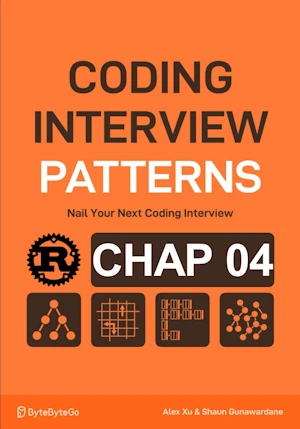Linked List Midpoint

- Given a singly linked list, find ans return its middle node. If there are 2 middle nodes, returns the second one
The point:
- Use 2 ptrs : One fast and one slow
- Fast move 2 steps at a time (
fast = fast.next.next) - When fast ptr reaches the end of list, slow pointer is in the middle
- If len of list is odd => slow in the middle when fast.ext is None
- If len of list is even => slow on the second middle when fast is None (p 78)
Complexity :
| Time | Space |
|---|---|
| O(n) | O(1) |
- O(n) because we traverse the list
- O(1) in space because no growing datastructure are created
About Rust :
- We only need to read =>
Box<T> - YES : tested on the Rust Playground
type Link = Option<Box<Node>>; // type alias. Use Option and Box to allow an optional pointer to the next node
struct Node {
val: i32,
next: Link, // use the alias here for clarity
}
impl Node {
fn new(val: i32, next: Link) -> Self {
Self { val, next }
}
}
// Function to find the midpoint of the linked list
fn linked_list_midpoint(head: &Link) -> &Node {
let mut slow = head;
let mut fast = head;
// Traverse the list using two pointers
while let Some(f_node) = fast {
if let Some(f_next) = &f_node.next {
fast = &f_next.next;
if let Some(s_node) = slow {
slow = &s_node.next;
}
} else {
break;
}
}
// At this point, slow points to the midpoint node
slow.as_ref().unwrap()
}
// fn main(){ // no main() if this code runs in a Jupyter cell
{ // local scope to avoid issue with the lifetime of head during borrow
let mut head = None; // Start with an empty list (head is None)
let vals = vec![1, 2, 42, 7, 3];
for v in vals.into_iter().rev() {
head = Some(Box::new(Node::new(v, head)));
}
let mut current = &head;
while let Some(node) = current {
print!("{}->", node.val); // Access the value
current = &node.next; // Move to the next node
}
println!("None");
// Find and print the midpoint
let mid = linked_list_midpoint(&head);
println!("Value at midpoint: {}", mid.val);
} // end of local scope OR end of main()
1->2->42->7->3->None
Value at midpoint: 42
()
If asked to return the first midpoint when there are 2 middle nodes
About Rust :
- YES : tested on the Rust Playground
type Link = Option<Box<Node>>; // type alias. Use Option and Box to allow an optional pointer to the next node
struct Node {
val: i32,
next: Link, // use the alias here for clarity
}
impl Node {
fn new(val: i32, next: Link) -> Self {
Self { val, next }
}
}
// Function to find the midpoint of the linked list
fn linked_list_midpoint(head: &Link) -> &Node {
let mut slow = head;
let mut fast = head;
while let Some(f_node) = fast {
if let Some(f_next) = &f_node.next {
if let Some(f_next_next) = &f_next.next {
// Move fast forward two steps
fast = &f_next_next.next;
// Move slow forward one step
if let Some(s_node) = slow {
slow = &s_node.next;
}
continue; // Explicit, but not necessary
}
}
break;
}
// At this point, slow points to the midpoint node
slow.as_ref().unwrap()
}
// fn main(){ // no main() if this code runs in a Jupyter cell
{ // local scope to avoid issue with the lifetime of head during borrow
let mut head = None; // Start with an empty list (head is None)
let vals = vec![1, 2, 4, 7];
for v in vals.into_iter().rev() {
head = Some(Box::new(Node::new(v, head)));
}
let mut current = &head;
while let Some(node) = current {
print!("{}->", node.val); // Access the value
current = &node.next; // Move to the next node
}
println!("None");
// Find and print the midpoint
let mid = linked_list_midpoint(&head);
println!("Value at first midpoint: {}", mid.val);
} // end of local scope OR end of main()
1->2->4->7->None
Value at first midpoint: 2
()